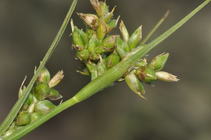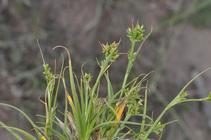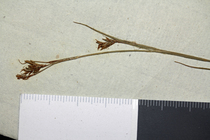
| Intro | | About | | Wiki | | Search traits | | Data explorer | | Literature | | Definitions | | Sources | | Webservices | | Statistics | | Feedback | | Editors | | Log in |
Cyperaceae taxon detailsCarex spartea Wahlenb.
1676041 (urn:lsid:marinespecies.org:taxname:1676041)
accepted
Species
Archaeocarex spartea (Wahlenb.) Pissjauk. · unaccepted
Carex densenervosa Chiov. · unaccepted
Carex dregeana var. major C.B.Clarke · unaccepted
Carex esenbeckiana var. elongata Boeckeler · unaccepted
Carex indica Schkuhr · unaccepted
Carex schimperiana Boeckeler · unaccepted
Carex spartea Thunb. · unaccepted
Carex sprengelii Boeckeler · unaccepted
Kobresia spartea (Wahlenb.) T.Koyama · unaccepted
Schoenoxiphium schimperianum (Boeckeler) C.B.Clarke · unaccepted
Schoenoxiphium sparteum (Wahlenb.) C.B.Clarke · unaccepted
Uncinia spartea Nees · unaccepted
Uncinia spartea (Wahlenb.) Spreng. · unaccepted
Uncinia sprengelii Nees · unaccepted > junior subjective synonym
terrestrial
Wahlenberg, G. (1803). Inledning til Caricographien. <em>Kongl. Vetenskaps Academiens Nya Handlingar.</em> 24: 138-170., available online at https://www.biodiversitylibrary.org/page/46986891
page(s): 149 [details]
Description Rhizome caespitose or not, with short to very long internodes, moderately stout, dark-brown. Flowering culms...
Description Rhizome caespitose or not, with short to very long internodes, moderately stout, dark-brown. Flowering culms (4.5)15–50(75) cm long, acutely, more rarely, obtusely trigonous, slightly scabrous at least to the apex, more rarely smooth, leafy up to ⅔ of its length, (0.4)0.6–1(1.4) mm wide at the middle. Leaves (0.4)1.5–3(5) mm wide, shorter, more rarely longer, than the inflorescence, soft to slightly rigid, straight to slightly curved at the apex, light green, flat, more rarely, scarcely carinate, in cross-section, scabrous along the margins and along the abaxial midrib to the apex; adaxial surface smooth to scarcely aculeate in some veins; ligule (0.5)1–2.5(3.5) mm long. Basal sheaths with lamina, more rarely, the lowermost bladeless, usually densely fibrous. Lowest bract of the inflorescence leaf-like, shorter, rarely longer, than the inflorescence, with a sheath (9)13–45 mm long. Inflorescence up to the upper ¾(⅘) of the length of the culm, branching up to 3 times; partial inflorescences (3)5–7(8), the (3)4–5(6) lowermost distant, pedunculate and erect, the (1)2–3 uppermost overlapping, subsessile, rarely all sessile and overlapping (in dwarf individuals). Glumiform perigynia and glumiform cladoprophylls absent. Tubular cladoprophylls always present. Utriculiform cladoprophylls rarely present. Male glumes 2–3.2 × (1.2)1.5–2.2 mm, ovate-lanceolate to widely ovate, straw-coloured to yellowish-brown, with a green central band, acute to ending in an aculeate mucro up to 0.3(0.5) mm long. Female glumes (1.9)2–3.2(3.7) × (1)1.3–1.9(2) mm, ovate, yellowish-brown, pale reddish brown or straw coloured, with a green central band, acute to ending in an aculeate mucro up to 2(6) mm long. Unisexual utricles (2)2.5–3.3(4.1) × (0.9)1.1–1.5(1.8) mm, widely ovoid to elipsoid, stipitate, straight, more rarely slightly curved, straw-coloured to brownish when mature, smooth, with conspicuous prominent veins over the entire surface, suberect to erecto-patent, abruptly contracted, very rarely attenuate, into a smooth, occasionally (some individuals from Eastern Cape) with a few, very disperse, minute prickless, asymmetrically bidentate or irregularly truncate beak (0.2)0.5–0.8(1) mm long; rachilla usually reaching the apex of the utricle, rarely protruding from it up to 0.2(0.4) mm. Bisexual utricles frequently present, widely and obliquely truncate at the apex. Achenes (1.8)1.9–2.6(2.9) × (0.8)1–1.2(1.4) mm, ellipsoid-trigonous, more or less straw-coloured to brown when mature, tipped by a very short, obtusely trigonous, sometimes slightly and shortly neck-like, rarely asymmetric, persistent style base. [details]
Cyperaceae Working Group. (2025). [see How to cite]. Global Cyperaceae Database. Carex spartea Wahlenb.. Accessed at: https://www.cyperaceae.org/aphia.php?p=taxdetails&id=1676041 on 2025-06-03
Date action by 2024-12-10 11:47:54Z unchecked db_admin
Nomenclatureoriginal description
Wahlenberg, G. (1803). Inledning til Caricographien. <em>Kongl. Vetenskaps Academiens Nya Handlingar.</em> 24: 138-170., available online at https://www.biodiversitylibrary.org/page/46986891 page(s): 149 [details] original description (of Carex schimperiana Boeckeler) Böckeler, O. (1876). Die Cyperaceen des königlichen Herbariums zu Berliln. Linnaea , 40(6): 385-452., available online at https://www.biodiversitylibrary.org/page/123532#page/329/mode/1up page(s): 373 [details] original description (of Uncinia spartea Nees) Nees von Esenbeck, C.G.D. (1835). Cyperaceae Capenses Secundum Novissimas Ecklonii Collectiones. In: von Schlechtendal, D.F.L. (ed.), Linnaea: Journal für die Botanik in ihrem ganzen Umfange 10. Missouri Botanical Garden. pp. 129-207., available online at https://www.biodiversitylibrary.org/page/100011#page/134/mode/1up page(s): 205 [details] original description (of Uncinia sprengelii Nees) Nees von Esenbeck, C.G.D. (1835). Cyperaceae Capenses Secundum Novissimas Ecklonii Collectiones. In: von Schlechtendal, D.F.L. (ed.), Linnaea: Journal für die Botanik in ihrem ganzen Umfange 10. Missouri Botanical Garden. pp. 129-207., available online at https://www.biodiversitylibrary.org/page/100011#page/134/mode/1up page(s): 205 [details] original description (of Carex densenervosa Chiov.) Chiovenda, E. (1911). Plantae novae vel minus notae e regione aethiopica. In: Pirotta, R. (ed.), Annali di botanica, vol. 9, pp. 125-152. Roma., available online at https://www.biodiversitylibrary.org/page/3385922#page/148/mode/1up page(s): 149 [details] original description (of Carex sprengelii Boeckeler) Böckeler, O. (1876). Die Cyperaceen des königlichen Herbariums zu Berliln. Linnaea , 40(6): 385-452., available online at https://www.biodiversitylibrary.org/page/123532#page/329/mode/1up page(s): 371 [details] original description (of Carex indica Schkuhr) Schkuhr, C. (1801). Beschreibung und Abbildung der Theils bekannten : Theils noch nicht beschriebenen Arten von Riedgrasern nach eigenen Beobachtungen und vergrosserter Darstellung der kleinsten Theile. 1., available online at https://www.biodiversitylibrary.org/page/15462554#page/7/mode/1up page(s): 37 [details] original description (of Carex spartea Thunb.) Thunberg, C.P. (1811). <em>Flora capensis.</em> 1. page(s): 343 [details] original description (of Carex dregeana var. major C.B.Clarke) Clarke, C.B. (1898). Cyperaceae. In: Thiselton-Dyer, W.T. (ed.), Flora capensis: being a systematic description of the plants of the Cape colony, Caffraria, & Port Natal (and neighbouring territories). Vol. VII. Pontederiaceae to Gramineae, pp. 149-310. L. Reeve & Co., Covent Garden; Williams & Norgate, Covent Garden, London., available online at https://www.biodiversitylibrary.org/page/30235904#page/157/mode/1up page(s): 303 [details] original description (of Carex esenbeckiana var. elongata Boeckeler) Böckeler, O. (1876). Die Cyperaceen des königlichen Herbariums zu Berliln. Linnaea , 40(6): 385-452., available online at https://www.biodiversitylibrary.org/page/123532#page/329/mode/1up page(s): 373 [details] basis of record Plants of the World Online (POWO). , available online at https://powo.science.kew.org/ [details] Taxonomytaxonomy source
Luceño, M.; Villaverde, T.; Márquez-Corro, J. I.; Sánchez-Villegas, R.; Maguilla, E.; Escudero, M.; Jiménez-Mejías, P.; Sánchez-Villegas, M.; Miguez, M.; Benítez-Benítez, C.; Muasya, A. M.; Martín-Bravo, S. (2021). An integrative monograph of <i>Carex</i> section <i>Schoenoxiphium</i> (Cyperaceae). <em>PeerJ.</em> 9: e11336., available online at https://doi.org/10.7717/peerj.11336 [details] Available for editors
 Present Present  Inaccurate Inaccurate  Introduced: alien Introduced: alien  Containing type locality Containing type locality
From editor or global species database
Description Rhizome caespitose or not, with short to very long internodes, moderately stout, dark-brown. Flowering culms (4.5)15–50(75) cm long, acutely, more rarely, obtusely trigonous, slightly scabrous at least to the apex, more rarely smooth, leafy up to ⅔ of its length, (0.4)0.6–1(1.4) mm wide at the middle. Leaves (0.4)1.5–3(5) mm wide, shorter, more rarely longer, than the inflorescence, soft to slightly rigid, straight to slightly curved at the apex, light green, flat, more rarely, scarcely carinate, in cross-section, scabrous along the margins and along the abaxial midrib to the apex; adaxial surface smooth to scarcely aculeate in some veins; ligule (0.5)1–2.5(3.5) mm long. Basal sheaths with lamina, more rarely, the lowermost bladeless, usually densely fibrous. Lowest bract of the inflorescence leaf-like, shorter, rarely longer, than the inflorescence, with a sheath (9)13–45 mm long. Inflorescence up to the upper ¾(⅘) of the length of the culm, branching up to 3 times; partial inflorescences (3)5–7(8), the (3)4–5(6) lowermost distant, pedunculate and erect, the (1)2–3 uppermost overlapping, subsessile, rarely all sessile and overlapping (in dwarf individuals). Glumiform perigynia and glumiform cladoprophylls absent. Tubular cladoprophylls always present. Utriculiform cladoprophylls rarely present. Male glumes 2–3.2 × (1.2)1.5–2.2 mm, ovate-lanceolate to widely ovate, straw-coloured to yellowish-brown, with a green central band, acute to ending in an aculeate mucro up to 0.3(0.5) mm long. Female glumes (1.9)2–3.2(3.7) × (1)1.3–1.9(2) mm, ovate, yellowish-brown, pale reddish brown or straw coloured, with a green central band, acute to ending in an aculeate mucro up to 2(6) mm long. Unisexual utricles (2)2.5–3.3(4.1) × (0.9)1.1–1.5(1.8) mm, widely ovoid to elipsoid, stipitate, straight, more rarely slightly curved, straw-coloured to brownish when mature, smooth, with conspicuous prominent veins over the entire surface, suberect to erecto-patent, abruptly contracted, very rarely attenuate, into a smooth, occasionally (some individuals from Eastern Cape) with a few, very disperse, minute prickless, asymmetrically bidentate or irregularly truncate beak (0.2)0.5–0.8(1) mm long; rachilla usually reaching the apex of the utricle, rarely protruding from it up to 0.2(0.4) mm. Bisexual utricles frequently present, widely and obliquely truncate at the apex. Achenes (1.8)1.9–2.6(2.9) × (0.8)1–1.2(1.4) mm, ellipsoid-trigonous, more or less straw-coloured to brown when mature, tipped by a very short, obtusely trigonous, sometimes slightly and shortly neck-like, rarely asymmetric, persistent style base. [details]
To Biodiversity Heritage Library (1 publication) (from synonym Carex schimperiana Boeckeler)
To Biodiversity Heritage Library (10 publications) (from synonym Schoenoxiphium sparteum (Wahlenb.) C.B.Clarke) To Biodiversity Heritage Library (17 publications) To Biodiversity Heritage Library (17 publications) (from synonym Carex spartea Thunb.) To Biodiversity Heritage Library (18 publications) (from synonym Uncinia spartea (Wahlenb.) Spreng.) To Biodiversity Heritage Library (18 publications) (from synonym Uncinia spartea Nees) To Biodiversity Heritage Library (2 publications) (from synonym Carex densenervosa Chiov.) To Biodiversity Heritage Library (67 publications) (from synonym Carex sprengelii Boeckeler) To Biodiversity Heritage Library (91 publications) (from synonym Carex indica Schkuhr) To European Nucleotide Archive, ENA (Carex indica) (from synonym Carex indica Schkuhr) To European Nucleotide Archive, ENA (Carex schimperiana) (from synonym Carex schimperiana Boeckeler) To European Nucleotide Archive, ENA (Carex spartea) To European Nucleotide Archive, ENA (Carex spartea) (from synonym Carex spartea Thunb.) To European Nucleotide Archive, ENA (Carex sprengelii) (from synonym Carex sprengelii Boeckeler) To GenBank (33 nucleotides; 4 proteins) (from synonym Carex schimperiana Boeckeler) To GenBank (67 nucleotides; 9 proteins) (from synonym Schoenoxiphium sparteum (Wahlenb.) C.B.Clarke) To International Plant Names Index (IPNI) (from synonym Schoenoxiphium sparteum (Wahlenb.) C.B.Clarke) To International Plant Names Index (IPNI) (from synonym Uncinia sprengelii Nees) To International Plant Names Index (IPNI) (from synonym Uncinia spartea Nees) To International Plant Names Index (IPNI) (from synonym Uncinia spartea (Wahlenb.) Spreng.) To International Plant Names Index (IPNI) (from synonym Carex schimperiana Boeckeler) To International Plant Names Index (IPNI) To International Plant Names Index (IPNI) (from synonym Schoenoxiphium schimperianum (Boeckeler) C.B.Clarke) To International Plant Names Index (IPNI) (from synonym Archaeocarex spartea (Wahlenb.) Pissjauk.) To International Plant Names Index (IPNI) (from synonym Kobresia spartea (Wahlenb.) T.Koyama) To International Plant Names Index (IPNI) (from synonym Carex indica Schkuhr) To International Plant Names Index (IPNI) (from synonym Carex densenervosa Chiov.) To International Plant Names Index (IPNI) (from synonym Carex sprengelii Boeckeler) To International Plant Names Index (IPNI) (from synonym Carex dregeana var. major C.B.Clarke) To International Plant Names Index (IPNI) (from synonym Carex spartea Thunb.) To Plants of the World Online (from synonym Carex spartea Thunb.) To Plants of the World Online (from synonym Schoenoxiphium caricoides var. major (C.B.Clarke) C.B.Clarke) To Plants of the World Online (from synonym Carex dregeana var. major C.B.Clarke) To Plants of the World Online (from synonym Carex sprengelii Boeckeler) To Plants of the World Online (from synonym Carex indica Schkuhr) To Plants of the World Online (from synonym Uncinia spartea Nees) To Plants of the World Online (from synonym Kobresia spartea (Wahlenb.) T.Koyama) To Plants of the World Online (from synonym Archaeocarex spartea (Wahlenb.) Pissjauk.) To Plants of the World Online To Plants of the World Online (from synonym Carex schimperiana Boeckeler) To Plants of the World Online (from synonym Uncinia spartea (Wahlenb.) Spreng.) To Plants of the World Online (from synonym Carex densenervosa Chiov.) To Plants of the World Online (from synonym Schoenoxiphium schimperianum (Boeckeler) C.B.Clarke) To Plants of the World Online (from synonym Uncinia sprengelii Nees) To Plants of the World Online (from synonym Schoenoxiphium sparteum (Wahlenb.) C.B.Clarke) To Royal Botanic Garden Edinburgh Herbarium (Carex schimperiana E00286063 isotype 1) (from synonym Carex schimperiana Boeckeler) To Royal Botanic Gardens, Kew (Schoenoxiphium sparteum K000693805 type 1) (from synonym Schoenoxiphium sparteum (Wahlenb.) C.B.Clarke) To Royal Botanic Gardens, Kew (Schoenoxiphium sparteum K000693808 type 1) (from synonym Schoenoxiphium sparteum (Wahlenb.) C.B.Clarke) To Royal Botanic Gardens, Kew (Schoenoxiphium sparteum K000693809 type 1) (from synonym Schoenoxiphium sparteum (Wahlenb.) C.B.Clarke) To Royal Botanic Gardens, Kew (Schoenoxiphium sparteum K000693814 type 1) (from synonym Schoenoxiphium sparteum (Wahlenb.) C.B.Clarke) |














